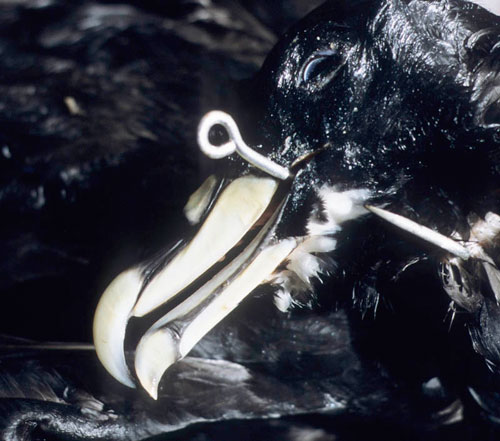Researchers based in Uruguay have recently published a paper in the journal Aquatic Living Resources assessing the impacts of the Uruguayan pelagic longline fleet on three ACAP-listed species. The abstract of their publication follows.
The Black-browed Thalassarche melanophris and Atlantic Yellow-nosed Thalassarche chlororhynchos Albatrosses and the White-chinned Petrel Procellaria aequinoctialis are the seabird species most frequently captured by pelagic longline fisheries in the south-west Atlantic. This study estimates this type of bycatch and describes the spatial-temporal patterns of the incidental capture of these species by the Uruguayan pelagic longline fleet, based on data collected by scientific observers on 47 fishing trips from 2004 to 2007. Three generalized linear models (GLM) models were employed to predict bycatch for each species based on the observed data. We also developed a spatio-temporal species-specific analysis. Captures were recorded in Uruguayan waters, mainly over the slope and depth waters, and in international waters adjacent to Uruguay, the north of Argentina, and the south of Brazil. The highest catch rates for Black-browed Albatrosses and White-chinned Petrels were recorded on the Uruguayan slope from fall to spring, while the highest values for Atlantic Yellow-nosed Albatrosses were recorded further to the north, in the international waters off Brazil in late winter. The average estimated number of Black-browed and Atlantic Yellow-nosed Albatrosses and White-chinned Petrels caught during the study period was 1683, 257 and 239 birds, respectively. Taking into account the total effort of the fleet, these values represent an estimated catch rate of 0.276, 0.042, and 0.039 birds/1000 hooks for these species, respectively. The results of the present study suggest that the annual impact of this fishery is medium to high on the black-browed albatross, low on the Atlantic Yellow-nosed Albatross and low on the White-chinned Petrel. However, the situation of these species in the south-west Atlantic should be viewed with considerable concern, as our understanding of the impact of the bycatch on their populations requires more research. Any effort to reduce seabird mortality in the southern hemisphere should target this geographic region.

With thanks to Sebastián Jiménez, Proyecto Albatros y Petreles - Uruguay
Reference:
Sebastián Jiménez, S.., Abreu, M. Pons, Ortiz, M. & Domingo, A. 2010. Assessing the impact of the pelagic longline fishery on albatrosses and petrels in the southwest Atlantic. Aquatic Living Resources 23: 49-64.

John Cooper, ACAP Information Officer, 19 March 2010

 English
English  Français
Français  Español
Español